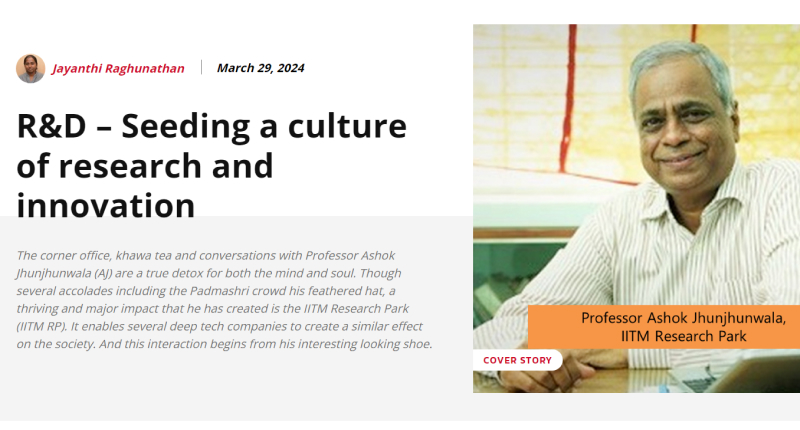April 1, 2024: Industrial Economist: The corner office, khawa tea, and conversations with Professor Ashok Jhunjhunwala (AJ) are a true detox for both the mind and soul. Though several accolades, including the Padmashri, crowd his feathered hat, a thriving and major impact that he has created is the IITM Research Park (IITM RP). It enables several deep tech companies to create a similar effect on society. And this interaction begins with his interesting-looking shoe.
When I complemented on them, AJ said, “This shoe is from an incubated company by three alumni from National Institute for Design. They wanted to do something different and I was talking to them of farmers plight due to snake bites and how their footwear wouldn’t last long due to the nature of their work.” This was the starting point of Earthen Tunes. The wool that they source from local sheep grazing communities made the key difference. It is an all-weather, all terrain shoe that is breathable and easily washable. The team still had the problem of offering it at a low price for the farmers and then developed another variation of the same shoe that would be sold at a small premium to cross subsidies the farmer shoes. Until now they have offered 1200+ shoes for farmers across 17 states and also partnered with NGOs to reach their goal towards touching the feet of a million farmers. “I have been wearing them for two years and they are extremely comfortable,” vouched AJ on the quality.
AUTONOMY IS THE KEY FOR R&D COMMERCIALISATION
IITM RP has partnered with the National Institute of Rural Development, Hyderabad to motivate such rural entrepreneurship with an objective to create products from there to take to urban centres and generate value, wealth and employment in the villages.
In India, the focus on R&D is critical for transitioning towards a knowledge-based economy. However, there’s a notable disparity between established R&D institutions and entrepreneurial ventures. While both sectors engage in R&D, startups demonstrate a higher success rate in commercialising their innovations. “The discrepancy lies in the funding and operational autonomy between the two. Startups typically receive funding from venture capital or angel investors who assess the product and the team before investing. Once funded, they operate autonomously, making decisions without constant oversight on expenditure. In contrast,
established R&D institutions face stringent regulations and scrutiny. They are often bound by predefined project plans and strict expenditure guidelines, limiting their flexibility and autonomy. Consequently, the focus shifts towards meeting bureaucratic requirements rather than pushing the boundaries of innovation,” explained AJ.
To foster innovation, it is well known that three sets of people are needed: academia who possess extensive and in-depth knowledge, industry which understands how to develop marketable products and enthusiastic young talents. However, despite this widely recognised concept, achieving seamless collaboration among these groups on a large scale has remained elusive. But IITM RP has successfully created a conducive and vibrant environment that has incubated more than 350 tech startups and facilitated partnerships with some 150 Indian and foreign companies.
THE BIRTH OF THE RESEARCH PARK
“Nearly 25 years ago, I recognised this need for collaboration. However, a model on this scale was never explored,” highlighted AJ. Even from the early days of his career, AJ had observed the clear divide between academia and industry. While academia focused on research and publication, industry imported technology for production. This disconnect prompted him to explore ways to bridge the gap between them. His aim was for academic research to contribute directly to products that could be manufactured by local industries. This endeavor posed several
challenges, but the first development came when an industry offered resources to solve an issue in its process. Since then, there was no looking back. Through word of mouth, companies approached IIT M with their challenges. It in turn spurred a wave of breakthroughs.
“As our efforts expanded, we recognised the need to do this on a larger scale. In 1998, the concept of the IIT Madras Research Park took shape. When I mentioned of this to IIT alumni in US, they were all excited. At that time, Professor Natarajan was the director and Professor Muthu Krishnan was the deputy director, and both supported and encouraged me to figure out a way to do it. The initial doubts from industry peers about implementing the project within IIT, due to regulatory constraints and space limitations, made sense. The consensus was that the
initiative needed to be located outside IIT but in close proximity. This led to the idea of establishing a facility within cycling distance of IIT,” detailed AJ on the journey.
Sourcing land was a major challenge but a chance encounter with the chief secretary of Tamil Nadu in 2006 opened doors. After presenting the concept to then chief minister, J Jayalalithaa, a decision was made to allocate land adjacent to IIT Madras for the project. “In fact the land was earlier called Jayalalithaa Film City, but she decided to part it for this initiative,” reminisced AJ. But before the efforts could be finalised, a new government sworn in and it felt like back to square one. AJ’s determination did bore fruit as the then chief secretary’s idea of creating a new
file for the new Chief Minister worked.
CREATING VALUE OF ABOUT RS 45,000 CRORE
To fund the initiative, various instruments were approached like seed funding, funds from
alumni, government and bank loans. Over time, the project gained momentum, and the research park was established as an independent entity, governed by a diverse board comprising government representatives, industrialists and faculty members.
“Initially, there were doubts if this would succeed. However, within our team, we fostered a strong sense of unity and determination, akin to a startup. Our goal was clear: to operate with the agility and drive of a startup, either achieving success or accepting failure,” detailed AJ. Today, the startups incubated are collectively valued at about Rs 45,000 crore.
THE SUCCESS FORMULA
IITM RP itself functions like a startup. “While some say it is necessary to pour in money, we are very stingy and believe that easy money hurts. There are more things than money like hard work, innovation, diligence and perseverance that determine success. With this approach more than 80 percent of companies can succeed,” stated AJ.
But what keeps Jhunjhunwala motivated? “It is the pursuit of objectives that drives me and I find joy in working toward them. The world still has a lot of problems and my objectives are as wide as them,” concluded Jhunjhunwala.
Publication: Industrial Economist
Read more by clicking on the link to the featured article below:
https://industrialeconomist.com/rd-seeding-a-culture-of-research-and-innovation/


